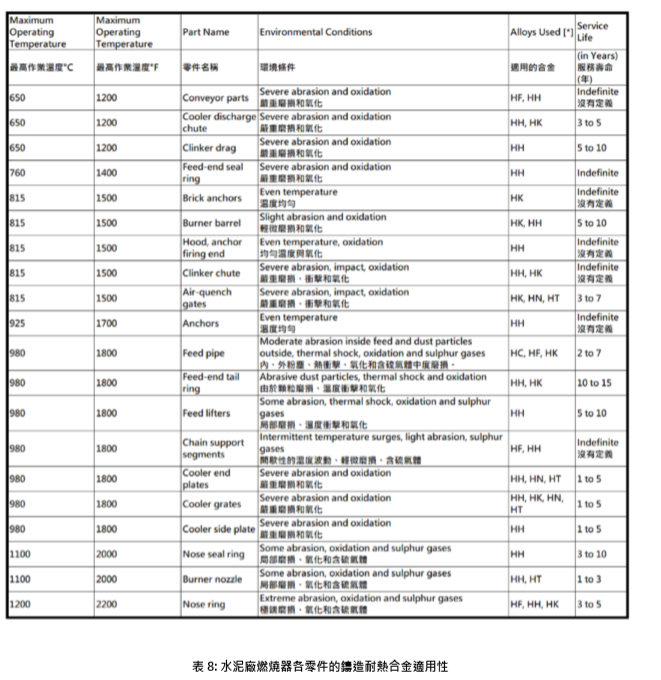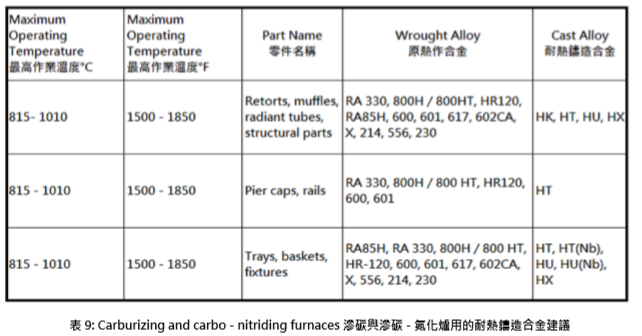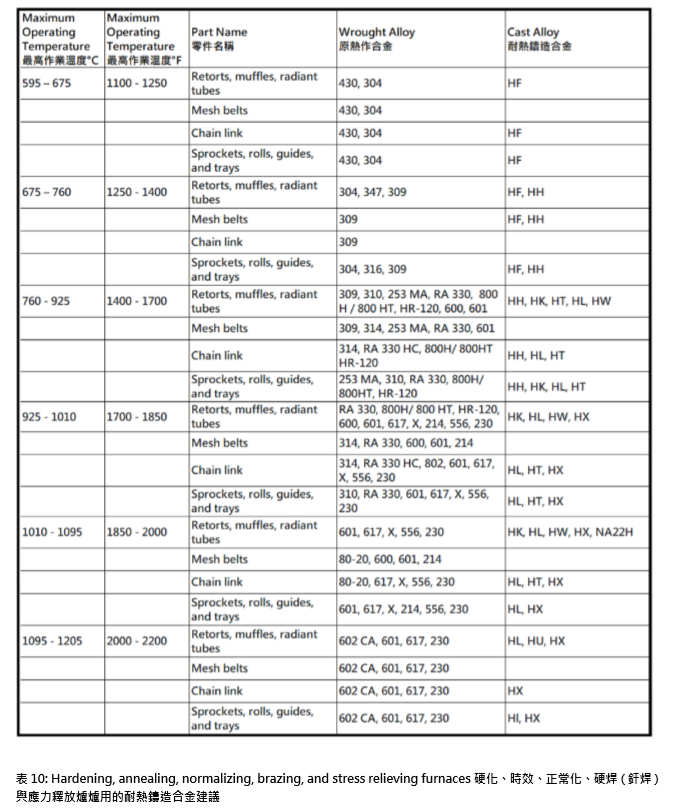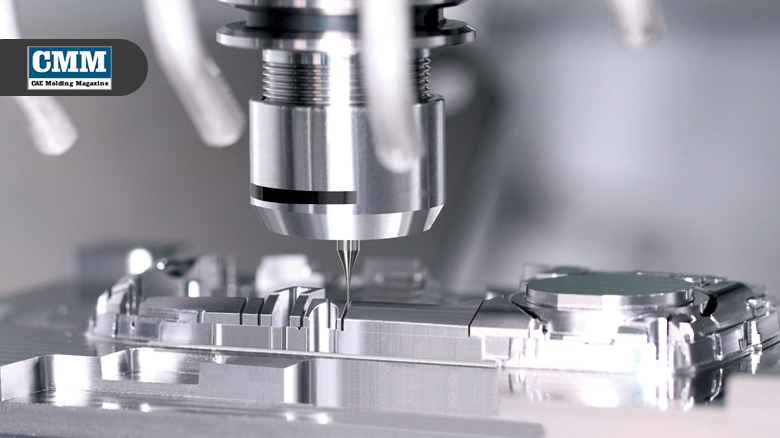■ ACMT/ 邱耀弘
接續四月刊 3.2.5
3.2.5Corrosion Resistance抗鏽蝕
請參考右圖表7
3.3 Applications应用 I
n terms of usage, the most important use of heatresistant castings is in metallurgical and other industrial furnaces. Iron-base alloys are most often used for this service, although significant amounts of nickel-base and cobalt-base alloys are also used. Other major applications of heatresistant castings include turbochargers, gas turbines, power-plant equipment, and equipment used in the manufacture of glass, cement, synthetic rubber, chemicals and petrochemical products.
在應用的方面,耐熱鑄件最重要的用途是用在冶金和其 他工業爐設備上。鐵基合金更是最常被用到這項目的服 務,雖然大量的鎳基和鈷基合金也被使用(但因價格和 經濟的考慮而選用了鐵基合金)。耐熱鑄件主要應用包 括渦輪增壓器、汽輪機、電站設備、設備與其零件,以 用來生產和製造玻璃、水泥、合成橡膠、化工和石化產 品。 3.3.1 Alloy Selection 合金選擇 Heat-resistant alloys are selected on basis of structural integrity in a specific application. Strength,
creep resistance and corrosion resistance are prime factors influencing alloy selection. Next in importance is cast ability, though it is difficult to obtain a quantitative evaluation of this factor. The part-geometry, and dimensions of the part to be cast and the alloy in which part is to be made are eventually critical factors. Our technical literature “Conceptual Framework for Casting Design” and “ Alloy Characteristics Affect Casting Design”, discusses the castingability of a part in a particular alloy to in a lucid manner and to sufficient depth.
耐熱合金是根據特定應用下要求結構完整性而選擇 的,其強度、抗蠕變性和耐腐蝕性能是影響合金選擇 的主要因素。次一個重要的是被鑄造的能力,雖然很 難對這個因素進行定量評估,不過可以零件的幾何形 狀、鑄件的尺寸和零件要製造的合金最終都是關鍵因素。我們的技術文獻“鑄件設計的概念框架”和“合 金特性影響鑄造設計”,討論了在特定合金中的零件 以清晰的方式和足夠的深度鑄造的能力。
編者:粗體字的提醒給我們MIM業者依個清晰的思 路,如何獲得幾何形狀!這是我們的強項。
Proper selection of an alloy for elevated temperature service involves consideration of some or all of the following factors: 正確選擇高溫設備的合金需要考慮以下幾個或全部因素:
1.Required life of the part 零件的使用壽命
2.Range of temperature cycling (heating and cooling) 溫度迴圈範圍(加熱和冷卻)
3.Steepness of temperature gradient (rise or fall of temperature with respect to time) 溫度梯度的陡度 (溫度隨時間的上升或下降)
4.Heat-treating atmosphere (oxidizing, reducing, or carburizing) 熱處理工作的氣氛環境(氧化、還原或滲碳)
5.Contaminants and its percentage in the elevated temperature atmosphere (For example, the presence of sulphur gas) 高溫環境中的污染物及其百分比(例如,含硫氣體的 存在)
6.Complexity of-Casting design, gating design, runner and riser feeding systems, directional solidification, poly, columnar or single- crystal solidification 鑄件設計的複雜性、澆注系統設計、澆冒口系統、定向凝固、多晶、柱狀或單晶凝固。
7.Effect of heat-treatment on an alloy before put into use 熱處理對合金在使用前的影響
8.Further fabrication of the casting 鑄件的進一步製造(後加工)
9.Cost and availability of the alloy 合金的成本和可用性
When the total manufacturing cost and the projected service life of a cast article have been determined it then possible to do a value analysis, and determine the unit operation cost. Cost per hour of service life is the ultimate criterion in selection of a heat-resistant alloy. On such basis, an alloy that is more expensive in initial cost provides lower cost per hour of service than a less-expensive type of an alloy. The higher alloy in the heatresistant series, having higher cost, have lower life cycle cost than the lower series alloy, which are cheaper but eventually turn out to be more costlier, as they have shorter service life-cycle.
確定鑄件的總製造成本和預計使用壽命後,便可以進行價值分析,以確定單元運行成本,分析到每小時使用壽命是選擇耐熱合金的最終標準。在這樣的基礎 上,往往一種成本較貴的合金比低成本的合金提供每小時服務成本更低。在耐熱應用上採用更高耐熱的合金時,當然後具有較高的成本,不要因為使用低耐熱 等級的便宜解決方案,最終被證明是更昂貴的,因為他們有更短的服務生命週期。
編者:注意到成本的考慮是更換零件的工時和、設備 降溫再升溫所浪費的能源和時間,各位MIM同業一 定都清楚連續爐的故障帶來的經濟損失,甚至危害到從業人員的安全,不可不慎!
3.3.2 Example範例
●Case 1: Use of Cast Heat Resistant Alloy Bushings in a Glass Fiber Plant 案例研究1:鑄造耐熱合金套管在玻璃纖維廠的應用 The service life of cast heat resistant alloy bushings widely used in equipment for forming glass fibers indicate that at 1000 ° C (1830 ° F) ASTM ACI HF (20Cr-10Ni) is 50 days and that of ASTM ACI HK
(25Cr-20Ni) is 60-75 days. Higher life was achieved by using HH (26Cr-12Ni) alloy with higher nickel content to withstand operations at temperature up to 1100 ° C (2000 ° F). In this application, cast bushings are mounted in the fore-hearth of a glassmelting tank. Molten glass is fed by gravity to each bushing, flows through forming tips at bottom of the bushings and is mechanically drawn into elongated fibers. The diameter of each glass fiber is determined by the size of the hole in the bushing tip, the speed of pull, and the temperature and type of glass used. The bushing must be kept hot, so it is resistance heated by means of water-cooled clamps attached to terminals at each end. 鑄造耐熱合金套管廣泛應用於設備形成玻璃纖維表明,壽命的規範在 1000° C (1830° F) 以 ASTM/ACI HF (20Cr-10Ni) 為 50 天,ASTM/ACIHK (25Cr-20Ni) 則是 60-75 天,更高的壽命則採用規格為 ASTM/ACI HH (26Cr-12Ni),具有較高的鎳含量可承受操作在 1100°C(2000°F)高溫下。在這個應用中,鑄造耐熱 襯套安裝在玻璃熔窯的前爐膛中,熔融玻璃通過重力 作用於每個襯套,流經套管底部的成形尖端,機械地 被拉伸成細長的纖維。每個玻璃纖維的直徑取決於套 管尖端的孔的大小,拉的速度,以及使用的玻璃的溫度和類型。套管必須保持熱度,所以它是通過兩端連 接的水冷夾具來加熱的。
The cast bushings are subjected to corrosion and erosion resulting from passage of molten glass at high temperature and from the oxidizing effects of surrounding air. At 1000 ° C (1830 ° F), HF alloy with low chromium and nickel contents had an average life of only about 45 days. When it was replaced by HK alloy, it was found that the average life of bushing life to 77 days. This improvement was effected with only a moderate increase in alloy content suggested by us. When the equipment was used at 1010°C (1850°F), however it was necessary to use bushings made of an alloy rich in nickel, i.e. HT, HU, HW and HX. The average life of these bushings improved to about 230 days.
鑄造襯套受到高溫下熔融玻璃的通過和周圍空氣的氧 化作用而產生的腐蝕和侵蝕。在1000°C (1830°F), 低鉻和鎳含量的HF合金平均壽命只有45天左右。當 用HK合金替代時,發現套筒壽命平均為77天。
這種改進是由於我們建議的合金含量適度增加了鎳, 當設備被用來在1010°C (1850°F),就有必要使用了 更多含鎳量的合金,即HT, HW和HX。這些襯套的 平均壽命提高到大約230天。
● Case 2: Use of Cast Heat Resistant Alloys in a Cement Plant 案例研究2:在水泥工廠的耐熱合金應用
The cast-heat resistant alloys that are used for various components of burning layout in a cement mill are given in the table below. Significantly, more than one alloy can be used successfully in most of the twenty types of components listed. Environmental conditions that provide the basis for selection are also mentioned for each component.
下表中給出了用於水泥廠燃燒器各零件的鑄造耐熱合金(水泥是需要煅燒的)。重要的是,一種以上的合 金可以成功地應用於列出的二十種類型中的大多數零件,還為每個零件提供了選擇依據和環境條件。


● Case 3: Recommended Materials (Iron, Nickel and Cobalt Base alloys) for Furnace Parts and Fixtures, used in Heat Treating 案例研究3:推薦材料(鐵、鎳、或鈷基合金)作為熱 處理爐子的零件與夾治具
When more than one alloy is recommended, each has proved adequate, although service life varies in different installations because of the differences in exposure conditions. 當一種以上的合金被推薦時,每一種合金都被證明是足夠的耐用,儘管在不同的裝置中使用,其壽命因暴露條件的不同而有差異。
Registered trademarks include ( 註冊商標包括):
● CABOT
● HAYNES
● HASTELLOY (Haynes Intern ational Inc.)
●253 MA (Avesta Sheffiled Inc.)
● INCONEL
● INCOLOY
● NIMONIC (the Inco Alloys International group of companies)
●NICROFER (Krupp VDM GmbH)
●RA 330
●RA85H (Rolled Alloys Inc.)
● AISE is the American Iron and Steel Engineer of AISI the American Iron and Steel Institute./ AIS是美國鋼鐵工程研究所所屬的美國鋼鐵工程學會
●ASTM is the American Society of Testing Material./ ASTM是美國材料試驗學會
● ASM is the American Society of Metals International./ ASM是美國國際金屬學會
●ACI is the Alloy Casting Institute./ ACI是合金鑄造 研究所
● ASTM designations are the same as ACI designations. 耐熱鑄造合金牌號在 ASTM 的名稱與 ACI的名稱相同。
為了尊重英文版的ACME公司,將廣告原文也放入本 文中:For selecting the right alloy and developing solutions, for your specific heat resistance applications, contact Vishal Kumar at vishal@acmealloys.com
選擇合適的合金和開發解決方案,為您的特定的耐熱 性的應用,可以聯繫 vishal@acmealloys.com 聯繫人 Vishal Kumar
3.6 MIM耐熱鋼的可能性
當然可能,各位可以發現表11所列,ASTM的不銹鋼 系列牌號,含鎳量高的不銹鋼幾乎都入選了耐熱鋼系 列合金,大家耳熟能詳的 304、310、316 和 HK30, 這些已經是我們經常用於MIM量產的材料,鎳對於 鋼材的耐熱性能有明顯的提升作用,已經是公開的知 識;耐熱鋼的重點已經在第三部分的3.1~3.3小節說 的很清楚,不變形或是有限變形、機械性能尤其要能 承受熱蠕變。那麼,如果讀者有要開發上述表11內的 材料,請注意要有查閱這些公司的材料是否有專利上 的限制,否則會觸法的!!國內粉末噴製廠在2018年 有這麼多新機會,也歡迎噴粉專家們多多推廣呢!!
参考文件
1. Acme Alloys ™ / Technical Literature/ Heat Resistant Castings – Iron Base Alloys Page 1 of 9, Tel: +91-11-513 3021, 514 3474 /Fax: +91-11-540 5799, 514 6900, e-mail : contact@acmealloys.com, Web: www.acmealloys.com
2. Internet of AISE, ASTM, ASM, and ACI.
3. BASF PANACEA使用說明書
4.Marcel Sonderegger, Bruno Spruengli, “Optimised Sintering and Heat Treatment of the Nickel-free High-Nitrogen MIM-Steel X15CrMnMoN17-11-3 “, European Powder Metallurgy Association, Powder metallurgy congress & exhibition; Euro PM2006; Page 31-36■





